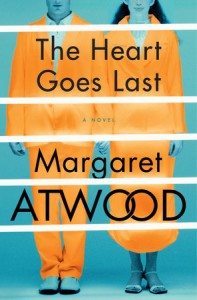326 pages, $26.95
Review by Mary Akers
As a thirty-year fan of Margaret Atwood, I eagerly purchased the first few episodes of The Heart Goes Last back in 2012 at Byliner, a reader’s website, when the working title was “Positron” and Atwood was still figuring out what form the story would take. When it grew into a novel and the opportunity arose to review it, I jumped at the chance.
As the novel opens, Stan and Charmaine are down-on-their-luck newlyweds. They have lost their home, their jobs, and are living out of their “third-hand Honda,” doing their best to avoid gangs of marauding rust-belt thugs after a financial crisis leaves middle class citizens marooned in a sea of debt and desperation.
First, Stan turns to his brother Con, a freelance mercenary with a murky employment history. Con gives Stan a small cash infusion but Stan leaves feeling tainted by the transaction. Meanwhile, Charmaine works part time at Pixel Dust, a derelict bar, and Grandma Win—alive only in her memory—pipes up periodically to remind her granddaughter of the pithy platitudes by which she lived her life: Miracles really can happen—it’s always darkest before the dawn. Love is what makes a house a home. All those things we never appreciated until we didn’t have them anymore. Better to close the lid when you flush, otherwise the germs fly around in the air and go up your nose. Charmaine, mostly grateful for the advice, sometimes “wishes Grandma Win would bug off out of her head.”
One night, while working at Pixel Dust, Charmaine sees an advertisement on TV for a new community that claims to solve the ills of society by having residents split their lives: one month in a suburban community, the next as a prison inmate. Onscreen, the text exhorts, “CONSILIENCE = CONS + RESILIENCE. DO TIME NOW, BUY TIME FOR OUR FUTURE.”
With few options open to them, Stan and Charmaine sign up, embarking on their new lives, happy and safe in the town of Consilience. One transfer day, however, restlessly vanilla Charmaine runs late making the bed and encounters the sexy “alternate husband” who lives in the house with his wife while Charmaine and Stan are imprisoned. A passionate affair ensues, on transfer days only, wherein Charmaine enjoys a few forbidden hours of intoxicating mock humiliation and sexual submission. He knows her only as Jasmine, she knows him only as Max.
When Stan discovers one of their notes, complete with the imprint of a lipsticked mouth, he becomes consumed by lurid fantasies of this exotic sexual creature—the presumed alternate wife, Jasmine-of-the-fuchsia-lipstick. He is certain she is everything that Charmaine is not and he must meet her. This misbegotten desire divides Stan and Charmaine and launches them into a series of decisions with dire tendrils that creep outward in every direction.
The brilliant complexity of Atwood’s title emerges as the story progresses. In the fatal injection procedure that is administered to undesirables, the heart, Charmaine learns, is the final organ to surrender—it goes last. Likewise, in a dramatic setup designed to test her loyalty—a battle between love and intellect—Charmaine feels her heart go last, “clinging on inside her all the time she was readying the needle…” Meanwhile, Stan, his life in jeopardy, explores his regrets believing he may be experiencing his last minutes:
Looking back on his life, he sees himself spread out on the earth like a giant covered in tiny threads that have held him down. Tiny threads of petty cares and small concerns and fears he took seriously at the time. Debts, timetables, the need for money, the longing for comfort, the earworm of sex, repeating itself over and over like a neural feedback loop…He should have left the disintegrating cities, fled the pinched, cramped life on offer there. Broken out of the electronic net, thrown away all the passwords, gone forth to range over the land, a gaunt wolf howling at midnight.
The burdensome demands of a modern life loom large in this novel, also the dual (and often competing) natures that live within us all. Can we ever hope to reconcile them? Should we try? Charmaine struggles with her duplicitous personas (passionate abject sex slave and chipper Stepford Pollyanna), as does Stan when he learns that his dreamgirl Jasmine is actually his buttoned-up wife Charmaine, who incongruously serves as a deadly Medications Administrator while in the Positron prison.
As this story nears its end, it veers delightfully toward farce. We encounter a troupe of gay Elvis impersonators, an eco-themed Vegas stage show Green Man Group, a team of Prostibot technicians making lifelike sex robots, and a stunningly beautiful woman with a brain-altering procedure that goes awry leaving her imprinted on and hopelessly infatuated with a blue knit teddy bear.
Atwood, in interviews, has described the process of writer-writing-for-reader-reading as the true science-fiction brain transfer, saying that the reader actually “finishes” her books. In that respect, the ending of The Heart Goes Last does not disappoint. Much as Offred, the heroine of Atwood’s first dystopian novel The Handmaid’s Tale, says in her final words, “And so I step up, into the darkness within; or else the light,” so at the conclusion of this book we are left to form our own ending for Charmaine. Atwood leaves her characters (and by extension her readers) to peer “down over the edge,” seeing only “…Mist, a sheer drop.” Readers are left to wonder, is it better to accept the life you are given and be happy with it? Or to be a lifelong questioner, forever seeking the better life?
To choose or not to choose, that is the question.
Well? Which will it be?
***
Mary Akers has published two books of short fiction with Press 53 and co-authored a non-fiction book that sold in seven countries. She has been a Bread Loaf waiter, a VCCA fellow, and is the proud and enthusiastic editor of r.kv.r.y. quarterly literary journal.
![[PANK]](https://pankmagazine.com/wp-content/themes/pank/assets/images/pank-logo-large.png)

